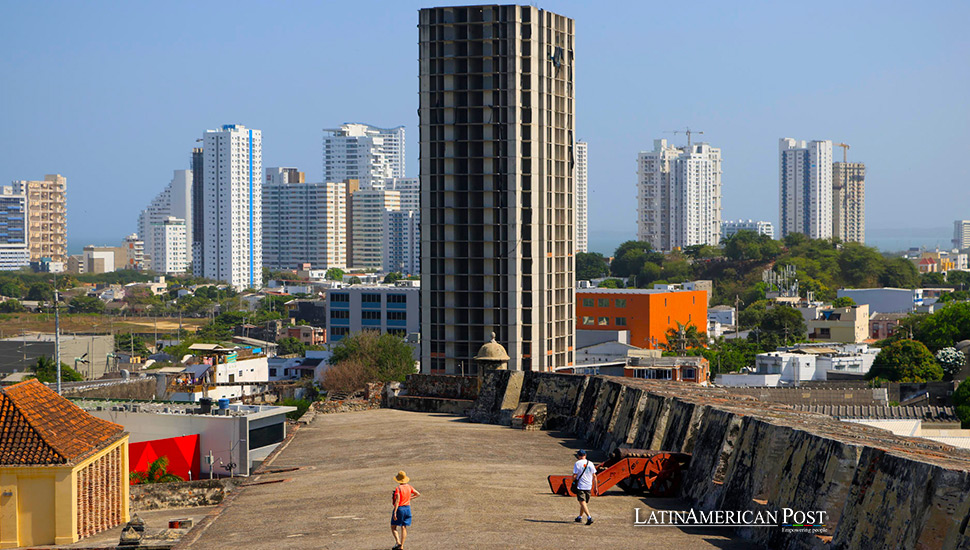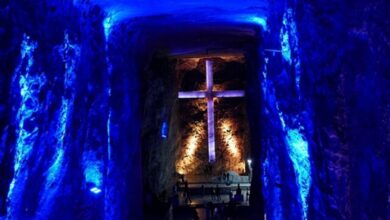Colombia’s Aquarela Building to be Demolished to Protect San Felipe de Barajas Castle

The Colombian city of Cartagena is set to demolish the Aquarela building, a controversial high-rise constructed near the San Felipe de Barajas Castle, a UNESCO World Heritage Site.
Envisioning Aquarela: A Bold Project Unveiled in 2017
The Aquarela project envisioned as five sleek 32-story towers, was met with excitement and controversy from the very beginning. Launched in 2017, it promised luxurious beachfront apartments with breathtaking views of the Caribbean Sea. However, the project’s proximity to the San Felipe de Barajas Castle, a UNESCO World Heritage Site and a symbol of Cartagena’s colonial past, quickly cast shadows over its future.
The Ministry of Culture, acting swiftly, raised concerns that the Aquarela building would obstruct the views of the castle and violate heritage protection laws. These concerns were echoed by UNESCO, which warned that the building’s construction “could hurt the Outstanding Universal Value of the property.”
Despite the warnings, construction on the first tower began. The sight of the partially built skyscraper looming over the historic castle became a source of contention, dividing residents and drawing international attention. Tourists visiting the castle expressed worry about the encroaching structure, while some locals questioned the ethics of prioritizing development over historical preservation.
The legal battle that ensued was lengthy and complex. Promotora Calle 47 developers argued that they had obtained all necessary permits and that the project complied with regulations. However, the Colombian court ultimately sided with the Ministry of Culture, ruling in 2022 that the Aquarela building posed a significant threat to the cultural and historical significance of the San Felipe de Barajas Castle.
The court order for demolition was met with mixed reactions. While heritage conservationists celebrated it as a victory, the future of the project’s investors remained uncertain. Promotora Calle 47 maintained their stance, claiming the demolition was “contrary to the law” and expressed concerns about the fate of the invested funds.
The demolition process itself is no small feat. Expected to take six months and cost an estimated $2.8 million, it involves a meticulous top-down dismantling to minimize the impact on surrounding areas and ensure the safety of workers and nearby residents.
A Cautionary Tale for Cartagena: Balancing Growth and Preservation
The saga of the Aquarela building serves as a cautionary tale for future developments in Cartagena and other historically rich cities. It underscores the importance of balancing economic growth and cultural preservation, ensuring that new projects respect the unique character and heritage that define these treasured places.
While the demolition marks the end of a contentious chapter, it also presents an opportunity for Cartagena to move forward. The city can learn from this experience and implement stricter regulations prioritizing sustainable development and protecting its irreplaceable historical and cultural treasures for generations to come.
Here are other examples to illustrate the complexities Latin American countries face in balancing business development with historical and cultural preservation:
Gran Torre Santiago, Chile:
The Gran Torre Santiago, standing 300 meters tall, is the tallest building in South America.
The project faced controversy regarding its impact on Santiago’s skyline and historic landmarks.
According to the Chilean National Monuments Council, Santiago’s historic center contains over 1,400 buildings of cultural heritage significance.
The debate over the Gran Torre Santiago reflects broader concerns about urban development’s impact on cultural heritage in Chilean cities.
Belo Monte Dam, Brazil:
The Belo Monte Dam, located in the Brazilian state of Pará, is one of the world’s most significant hydroelectric projects.
The dam’s construction has faced criticism for its environmental and social impact.
According to the Brazilian Institute of Environment and Renewable Natural Resources (IBAMA), the dam’s reservoir area could flood up to 500 square kilometers of rainforest and displace thousands of indigenous people.
Indigenous groups and environmental organizations have raised concerns about biodiversity loss and disruption of traditional livelihoods.
The project’s cost is estimated at around $17 billion.
Nuevo Aeropuerto Internacional de la Ciudad de México (NAICM), Mexico:
The NAICM, intended to replace the current Mexico City International Airport, was planned for construction in the Texcoco region.
The project faced opposition due to its environmental impact, including land subsidence and water depletion concerns.
According to Mexico’s National Water Commission (CONAGUA), the Texcoco lakebed where the airport was to be built is a crucial area for groundwater recharge and flood control.
Environmental impact assessments estimated that the project would affect the habitats of numerous species, including migratory birds.
The estimated cost of the NAICM was approximately $13 billion before the project was canceled.
Historical preservation in Cartagena, Colombia:
Cartagena is a UNESCO World Heritage Site renowned for its well-preserved colonial architecture and historic fortifications.
The Aquarela project’s controversy underscores the challenges of balancing development with heritage preservation in the city.
According to the Colombian Ministry of Culture, Cartagena’s historic center contains over 500 years of architectural heritage.
The legal battle over the Aquarela building highlighted the importance of upholding heritage protection laws and preserving the city’s unique cultural identity.
The demolition of the Aquarela building is estimated to cost $2.8 million and is expected to take six months to complete.
Also read: Colombia to Pioneer Digital Innovation Lab for Decarbonization and Energy Efficiency
These examples showcase the intricate dynamics when modern development clashes with preserving cultural and environmental heritage in Latin America. From towering skyscrapers to massive infrastructure projects, the region grapples with the imperative of progress while striving to safeguard its rich historical and natural legacies.




